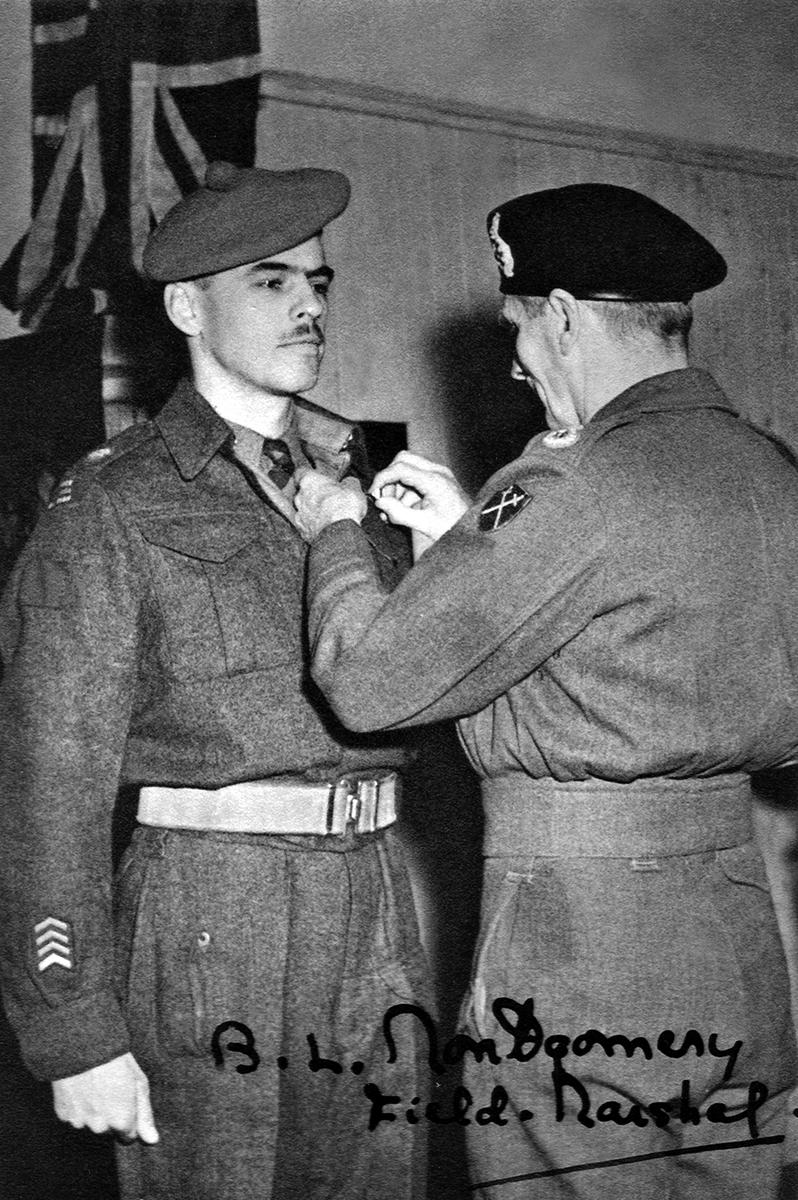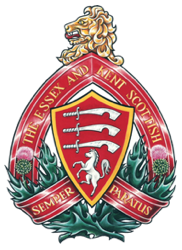Major Si Steele, MC and Operation GOODWOOD

Major T.E. Steele receives the Military Cross medal for his role at Verrières Ridge from Field Marshal B.L. Montgomery on 29 July 1944.
Major Telford Ezra “Si” Steele, MC, was a member of the Kent Regiment from 1939-1942, quickly attaining the ranks of sergeant then captain due to his leadership skills. In 1942, he joined The Essex Scottish Regiment as a captain to serve overseas during World War II, as the Kents were limited to duty in Canada. Many members of the Kent Regiment transferred to the Essex Scottish overseas, especially after the disastrous Dieppe Raid in August 1942. Steele saw action on the Western front after the regiment landed in Normandy.
Steele played a crucial role in Operation GOODWOOD, to drive three armoured divisions across the Caen Canal and Orne River to capture Bourgébus Ridge. This advance was part of the effort push the Germans toward Paris after the Normandy landings and expansion of the bridgehead since D-Day on June 6, 1944. One aspect of this plan was to dig in between Beauvoir Farm and St. André-sur-Orne. Captain Steele led D Company, The Essex Scottish since his predecessor company commander broke his leg playing baseball before going to France. The battleground was grim, littered with the bodies of soldiers from the South Saskatchewan Regiment which had advanced ahead of the Essex Scottish. Many soldiers were taken prisoner or were left injured on the battlefield, hoping that they would not be executed by S.S. soldiers. In this engagement, the first combat the regiment had seen since Dieppe, approximately half of the battalion were casualties.
The Essex Scottish breakthrough did not materialize so a more limited Operation ATLANTIC was launched on July 20 to take Verrières Ridge. This too failed so Operation SPRING was launched to take the territory and was successful. Verrières Ridge gave them access to much-needed fresh water and a high vantage point, and as such it was an important tactical gain. Holding the ridge was difficult due to German panzer divisions and strong German counterattacks, which made it very difficult to accomplish even small gains. In Operation COBRA, which followed SPRING, Captain Steele led his company to take the German outpost around le Noyer on 29 July 1944. The topography was largely flat with an orchard located at its northern point. He took command of the 17 Platoon to help 16 Platoon to take the northern point of the ridge while the south was being assaulted by others. Steele led the charge twice despite key losses, including his Bren gunner and his runner. The battle dissolved into bayonet fighting in the trenches, and with help from Sergeant-Major Les Dixon the Essex Scottish advanced to the north end of the ridge. The battalion lost thirty-five men in the attack. However, the capture of the ridge was considered a success. Major Steele was awarded the Military Cross for his bravery at Verrières Ridge.
In Operation VERITABLE in February 1945 near Goch and Calcar, Germany, Steele, now a major, and his D Company was tasked with securing individual farmhouses to assist in breaking the Siegfried Line defending the Rhine River. He was originally not supposed to be involved in the attack. He remarked that it would take a platoon to accomplish this feat. However, Steele was confident that he and three other men could do the job just as effectively. Steele was correct. They were able to take control of two farmhouses before Steele was shot in the leg through a window. Despite his severe wound, he was able to convey orders to ensure the success of his mission. He was found by a German soldier who took him prisoner. Pte. Peter Markowski, Steele’s driver, negotiated with the German soldier to let him take Major Steele back to the Canadian medical staff. The German soldier agreed, and Markowsky carried Steele on his back to the Canadian lines. This injury put Steele in the hospital for twenty-two months. Steele gave the regiment instructions via memos to plan the following attack, Operation BLOCKBUSTER, which was an attempt to capture the Hochwald Forest in March 1945. Steele received six medals over the course of his service in WW II: Military Cross, 1939-1945 Star, France and Germany Star, Defense Medal, Canadian Volunteer Service Medal, and War Medal 1939-1945.
The original plan for Army restructure in June 1954 called for the Essex Scottish to absorb the Kent Regiment. Major (Retired) Steele, a leading member of the Kent Regiment Association, advocated for the Kents to the Canadian Minster of Defence. He argued that the Kent Regiment has a distinct history and role in Canada’s national defence and therefore the regiment should not be rebadged as part of the Essex Scottish. If it were to be renamed, he requested that the Essex and Kent counties be represented equally. He predicted that anything less than equal treatment would breed resentment amongst the troops. Eventually, a decision was made to amalgamate the two regiments with the new name of The Essex and Kent Scottish effective October 1, 1954. For his efforts in World War II and his long service with the both the Kents and the Essex Scottish, the joint WO and Sergeants Mess and Officers Mess in the Ansell Armoury in Chatham, Ontario was named after Major Steele in 2009.
Steele continued to be involved in the Chatham community outside of his military pursuits, including coaching minor hockey and fundraising for local charities. His impact on the community was so significant that he received a citation for life-long commitment to selfless civic duty from the Mayor of Chatham on 10 November 1999, the first award of its kind.
Story by Nicole Pillon, Canada Summer Jobs 2022 participant
with The Essex and Kent Scottish Regiment Association
Sources
- Duty Nobly Done, The History of The Essex and Kent Scottish Regiment by Sandy Antal and Kevin R. Shackleton, 2006 – Chapter 12, Chapter 15
- Chatham-Kent Family Almanac
